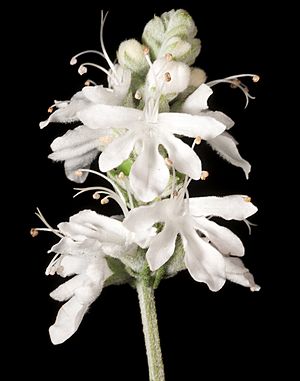Germanders facts for kids
Quick facts for kids Germanders |
|
|---|---|
 |
|
| Teucrium eremaeum | |
| Scientific classification |
|
| Kingdom: | Plantae |
| Clade: | Tracheophytes |
| Clade: | Angiosperms |
| Clade: | Eudicots |
| Clade: | Asterids |
| Order: | Lamiales |
| Family: | Lamiaceae |
| Subfamily: | Ajugoideae |
| Genus: | Teucrium L. (1753) |
| Type species | |
| Teucrium fruticans L.
|
|
| Species | |
|
See List of Teucrium species |
|
Teucrium is a group of flowering plants found all over the world. They are usually called germanders. These plants belong to the Lamiaceae family, which also includes mint! Germanders can be perennial herbs (meaning they live for more than two years and have soft stems) or shrubs (woody plants smaller than trees).
Their stems often have a square shape. Their leaves grow in pairs, one across from the other. The flowers usually grow in clusters called thyrses. The petals are mostly white or cream-colored and have different shapes.
Contents
What are Germanders Like?
Germander plants are either perennial herbs or shrubs. Their stems often have four corners and might have tiny hairs or sticky parts called glands.
Leaves and Flowers
The leaves of germanders grow in opposite pairs along the stem. They can be simple, or sometimes they have three smaller leaflets. The edges of the leaves can be smooth, lobed (like a hand), or serrated (like a saw).
The flowers usually grow in a cluster called a thyrse. Sometimes, they grow in smaller groups called cymes where the leaves meet the stem. Each flower has five sepals, which are like small leaves that protect the bud. These sepals are joined together at the bottom.
The main part of the flower, called the corolla, is usually white or cream-colored. It has five parts that form two "lips." The upper lip is usually very small. The lower lip has three parts, with the middle one often being bigger than the ones on the sides. There are four stamens (the parts that make pollen) attached near the base of the petals. After the flower is pollinated, the fruit develops into four small segments.
Naming Germanders
The group of plants known as Teucrium was first officially described in 1753 by a famous scientist named Carl Linnaeus. He wrote about them in his book Species Plantarum.
The name Teucrium was used by an ancient Greek doctor named Pedanius Dioscorides for some plants in this group. People believe the name comes from King Teucer of Troy. Legend says he used these plants as medicine.
Different Kinds of Germanders
There are about 300 different kinds, or species, of germanders around the world. Most of them are found in the Mediterranean region. About thirteen species of germanders grow only in Australia.
Ancient Germanders
Scientists have found fossils of germander seeds from a very long time ago!
Fossils from Siberia and Russia
Fossils of Teucrium tatjanae seeds have been found in western Siberia from the Oligocene (about 34 to 23 million years ago), Miocene (about 23 to 5 million years ago), and Pliocene (about 5 to 2.6 million years ago) periods. They have also been found in central and southern Russia from the Miocene and Pliocene, and in Lusatia (a region in Europe) from the Miocene. These fossil seeds look similar to the seeds of a germander species that still grows today, called Teucrium orientale.
Fossils from Germany
Fossil seeds of another ancient germander, Teucrium pripiatense, have been found in the Pliocene Borsoni Formation in the Rhön Mountains in central Germany.
Images for kids
See also
 In Spanish: Teucrium para niños
In Spanish: Teucrium para niños




